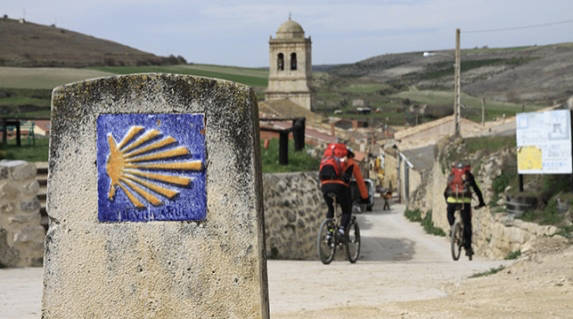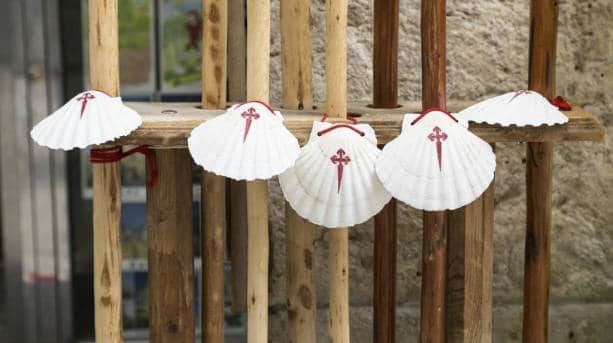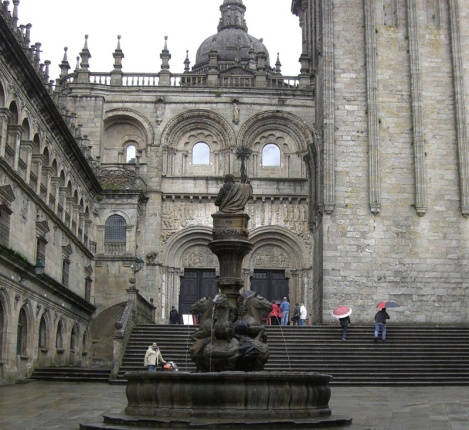SANTIAGO’S CATHEDRAL
Santiago’s Cathedral is the most important monument in the city. It’s located in the heart of the town. The building was finished in 17th century and the passage is done in a baroque style. This fascinating place is visited by 2,6 milion tourist every year because it’s a World Heritage Site and because it’s the end of the “Camino de Santiago”. The most amazing part of it, is the “Pórtico de la Gloria”. It had to be repared owing to the blows of the people, on a statue, that want to receive the intelligence of Maestro Mateo, the person who designed this part of the Cathedral.
La Catedral de Santiago es el monumento más importante de la ciudad. Se encuentra en el corazón de la ciudad. El edificio fue terminado en el siglo XVII y la fachada es de estilo barroco. Este fascinante lugar es visitado por 2,6 millones de turistas cada año ya que es Patrimonio de la Humanidad y porque es el final del Camino de Santiago. La parte más asombrosa es el Pórtico de la Gloria. Tuvo que ser reparado debido a los cabezazos de la gente, en una estatua, las cuales quieren recibir la sabiduría del maestro Mateo, la persona que diseñó esta parte de la Catedral.


“CAMINO DE SANTIAGO”
There are three ways to get to Santiago; Camino del Norte, Camino Francés and Camino Portugués.
This tradition started when the remainders of the Apostol Santigo were found and after that, Xacobeo’s year was created.Since then, people want to do this walk, and if you arrive at the Santiago’s Cathedral on the 25th of July and it’s Sunday your soul is going to be cleaned. The next Xacobeo’s year is going to be in 2021.
As you arrive to the place you pray to Apostol Santiago for you and your relatives to be safe.
In the Erasmus+ program we did 10 kilometers of this walk and through the path you connected with nature and you started to feel your spirit.
Hay tres maneras de llegar a Santiago: Camino del Norte, Camino Francés y Camino Portugués.
Esta tradición comenzó cuando se encontraron los restos del Apóstol Santiago y después se creó el año de Xacobeo. Desde entonces, la gente quiere hacer esta caminata, y si llegas a la Catedral de Santiago el 25 de julio y es domingo purificarás tu alma. El próximo año de Xacobeo será en el año 2021.
Al llegar a la catedral, rezas al Apóstol Santiago para que tus familiares y tú estéis a salvo.
En el programa Erasmus+ hicimos 10 kilómetros de esta caminata y por el camino conectamos con la naturaleza y empezamos a sentir nuestro espíritu.

SYMBOL OF THE “CAMINO”
The symbol of the shell came from a long way backwards. Perigrims, for prove that they have completed the way, catched a shell of a scallop and painted a red cross on it, then brought it home for it to keep their family safe.
El símbolo de la concha viene de años atrás. Los peregrinos, para probar que han completado el camino, cogen una concha de vieira y le pintan una cruz roja en el centro, luego la guardan en casa para que mantenga a su familia a salvo.

OLD PROFESSIONS
A lot of the streets in the old town of Santiago have the name of old professions that were very important in the city and where people used to practice them. Now, if you walk along Santiago you can see many names of streets such as: “Calle de la Azabachería” or “Calle de la Calderería”; and you can also see names of squares like “Plaza de las Praterías”
Muchas de las calles del casco antiguo de Santiago tienen el nombre de antiguas profesiones que eran muy importantes en la ciudad y dónde la gente solía practicarlas. Ahora, si caminas por Santiago puedes ver muchos nombres de calles como: Calle de la Azabachería o Calle de la Calderería; y también puedes ver nombres de plazas como Plaza de las Praterías.

Made by Elena Ramil Castro and Celtia Rio Santos

